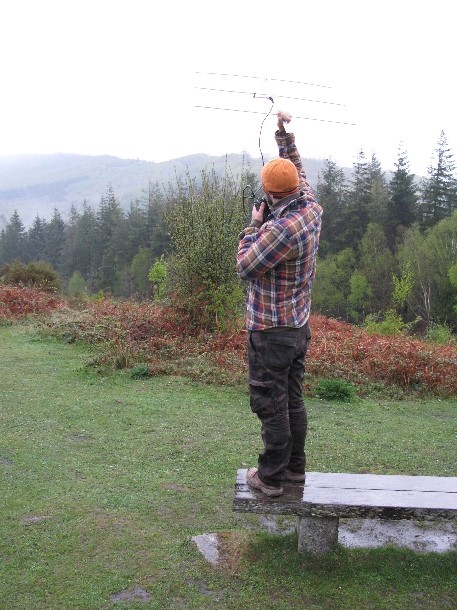April 2015 On Saturday 25th April the barbastelle bat tracking team met at the Yarner Woodland Centre for the third time to start their practical radio tracking training. Still keen to commit their time to the study, the 25 volunteers signed up and paired up into survey teams for the coming months’ work.

Back at the helm, Andy Carr (PhD researcher at the University of Bristol) outlined the training for the day. This would be the first time the volunteers would use the radio tracking equipment and, splitting into three groups, an experienced bat tracker was on hand to supervise each one. Andy continued to set the scene on the overall survey – how, earlier in the week a number of bats had been trapped to select one for tracking. A male barbastelle, now named Bert, was tagged and ready for action. Interestingly, another bat was trapped and suspected to be a recently discovered species of Alcathoe bat. It’s very similar to the barbastelle, so similar in fact, that only a DNA check on its droppings will confirm this new discovery, the first in Devon.
Time for the tracking training to begin for real. Fully equipped groups assembled outside to discuss plans to find a live tag hidden somewhere in the oak woods – a needle in a haystack! Setting the receiver to the right channel, aerial aloft, they were ready. The basic rule of radio tracking is to find a high vantage point, so all three groups set off on their three different routes to gain altitude.

Light rain had arrived and, pushing through knee-high wet bilberry the volunteers climbed, stopped, checked and listened for a signal. Gradually a feint beeping led the group through the trees, pausing now and again to make sure they were on track. As the beep got louder, careful adjustment of the “gain” sensitivity on the receiver indicated their distance from the target. Not far from the tag the volunteers needed to look for likely roost sites; split bark or torn, decaying braches on oak trees are the preferred home of the barbastelle.
Groups of volunteers who took different routes at the start began to converge. “It must be close now” they agreed. Walking in ever decreasing circles, only one or two trees had potential roost spots and finally, there it was. A pair of red eyes on a fabric bat nestled in the crack of a torn branch, but the transmitter tag was genuine though. A successful first stage of radio tracking training was rounded off with a chat about how radio tracking can be used to follow a moving bat and record its progress.
The Evening Shift for ‘Team Barbastelle’…

Resuming in the car park above the Bovey valley at 8pm the volunteers assembled with aerials and receivers to get their first “fix” on Bert’s roost location. The signal was weak and intermittent but benefited from a boost by the use of a Land Rover roof rack as an amplifier. Two way radios were shared out as groups of trackers set off to different vantage points around the valley. To have the best chance of picking up a signal a good promontory was found and volunteers waited, aerials raised and receivers hissing in anticipation. Rain came and went, clouds drifted around the valley and the sky darkened. The group down in the valley were the first to get a strong signal as they were reporting from outside Bert’s roost.
Birdsong gradually drifted away but still no sign of bats flying. A half-moon was visible between clouds and described by 11 year old Gillian over the two way radio that “the other half was behind the darkness”! Moths began to appear in the deepening gloom, skipping between gorse flowers, but still no bats. One tawny owl in the bottom of the valley was the only bird heard – then a bat fluttered overhead, taking us by surprise. Not Bert, but a bat at least, picking off the moths. In real darkness it dawned on the volunteers and experts alike that Bert wasn’t coming out. He’d probably fed well the previous night and, in the cold, damp conditions, decided to stay under cover. The general opinion was to concur with Bert and head home.
The weather may have been wet but the volunteers’ enthusiasm was not dampened. They had all learned a lot over the training day and would be back to hone their skills another night. Some will also be back to trap and tag more bats as female members of Bert’s colony will need to be recruited. With a bit more practice the new bat trackers will be able to put together the results and provide a full picture of the movements and habits of the rare barbastelles resident in these woods in East Dartmoor National Nature Reserve.
To read the complete series of Barbastelle Tracking Diaries:
Part 1
Part 2
Part 4
Part 5
Part 6
Part 7
Part 8
Part 9
Words and images for the Barbastelle Tracking Diary are by Matt Parkins
The Bovey Valley barbastelle tracking project is managed by the Moor than meets the eye Landscape Partnership comprising Dartmoor National Park Authority, the Woodland Trust and Natural England.
